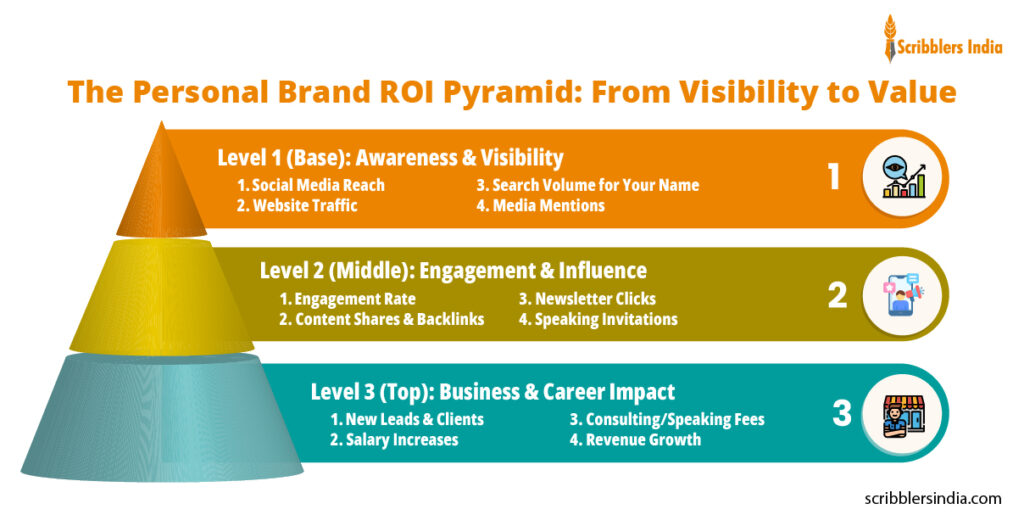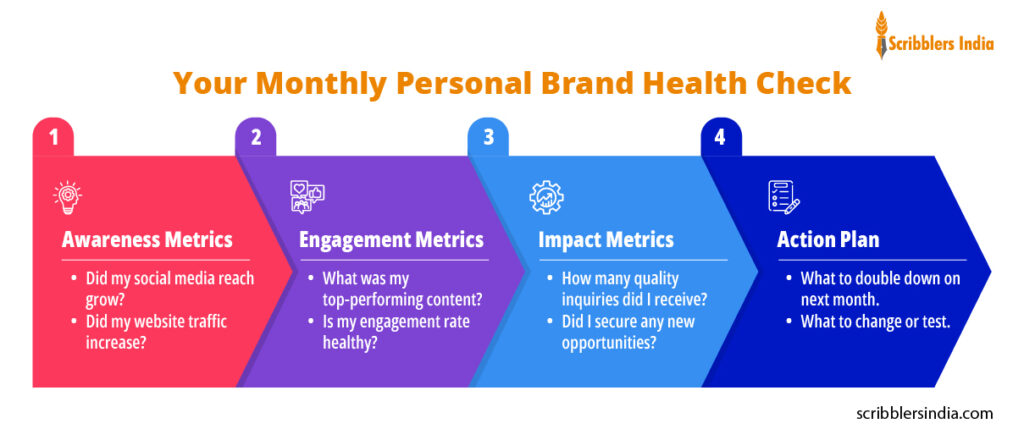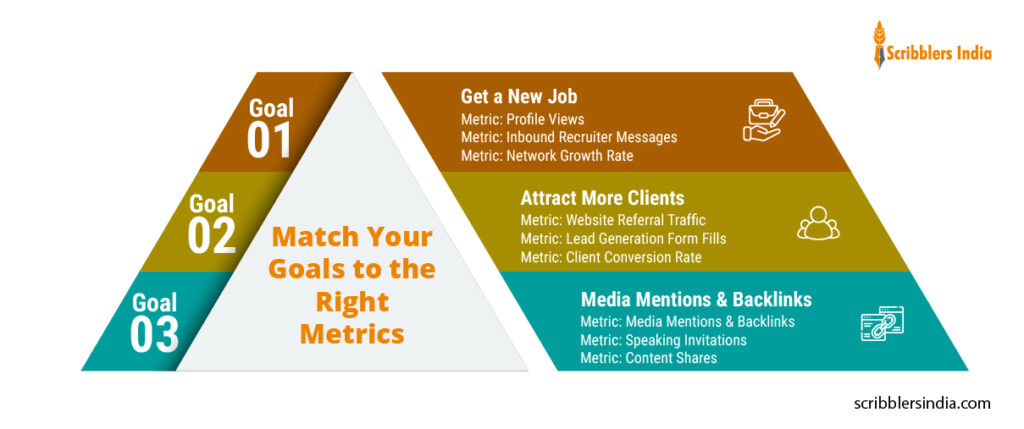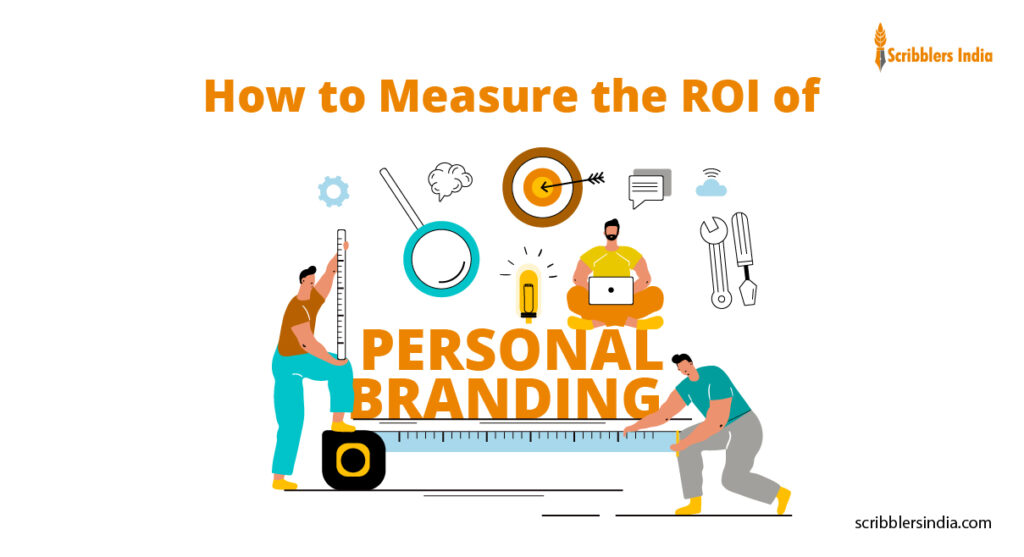You have likely noticed the constant conversation around personal branding. It is no longer a concept reserved for celebrities or CEOs; it is a critical tool for anyone looking to advance their career, grow a business, or build influence in their industry. Its rise is undeniable.
In simple terms, your personal brand is your professional reputation. It is the story people tell about your skills, experience, and character when you are not in the room. It is how you are perceived by colleagues, clients, and your industry at large.
This all sounds promising, but it leads to a crucial question: “Is the effort really worth it?” You invest significant time and sometimes money into building your presence. How do you know if these actions are actually paying off in a meaningful way? This uncertainty is a common challenge.
This guide is designed to demystify this process. We will break down how to measure the ROI of personal branding. We will provide you with a clear framework and actionable metrics to prove the value of your efforts and make smarter strategic decisions for your future.

What Does ROI Mean for Your Personal Brand?
ROI, or Return on Investment, is the value you receive back from the resources you put in. For a personal brand, your investment includes time spent creating content, money for tools or courses, and consistent networking efforts. The “return,” however, is often more complex than a simple dollar figure.
Unlike traditional marketing, where ROI might be a direct sales number, personal branding ROI is a mix of tangible and intangible benefits that unfold over the long term. A strong brand might not lead to a sale today, but it could land you a major promotion or a game-changing client six months from now. According to a recent study, 86% of B2B decision-makers say that thought leadership content has a significant impact on their purchasing decisions, showcasing the indirect but powerful financial return of a strong professional reputation.
Why is Measuring ROI of Personal Branding Important?
Tracking your progress is not just about numbers; it is about strategy and validation. When you track personal brand metrics, you empower yourself to build a more effective and rewarding professional life.
- Justify Your Investment: Clearly show yourself, your boss, or your partners that the time and resources you are dedicating are yielding positive results.
- Optimize Your Strategy: Data reveals what resonates with your audience. You can see which content, platforms, or topics are working and double down on them.
- Make Smarter Decisions: Your metrics guide your next steps, helping you decide whether to focus on LinkedIn, start a newsletter, or pursue speaking engagements.
- Attract Better Opportunities: When you can articulate the impact and reach of your brand, you become a more attractive candidate for high-level jobs, clients, and collaborations.
What Do You Want Your Personal Brand to Achieve?
You cannot measure the ROI of personal branding without first defining what “return” means to you. Your ROI is only meaningful when it is directly connected to clear, specific, and measurable goals. Without a target, you are just collecting data without purpose.
Before you look at any metric, you must ask yourself: “What is the primary objective of this effort?” Setting clear personal brand goals transforms your activities from random acts of content into a focused strategy for success. Here are some common goals:
- Secure a new job, promotion, or career transition.
- Attract more qualified clients for your freelance or consulting business.
- Become a recognized thought leader or go-to expert in your niche.
- Increase your overall earning potential through salary or business revenue.
- Build a powerful and supportive professional network.
- Drive sales for a specific product, course, or service you offer.

How Do Goals Help Measure Personal Branding Success?
Goals provide the context for your metrics. They are the foundation of any effort to measure the ROI of personal branding because they tell you which numbers actually matter.
- Connect Metrics to Goals: If your goal is to attract more clients, your most important metrics are not just likes and shares, but qualified leads and conversion rates.
- Tailor Your Measurement: If your goal is to become a thought leader, you will focus more on media mentions, content shares, and speaking invitations rather than direct sales. Different goals require different yardsticks for personal brand success.
How Do You Measure Brand Awareness and Visibility of Personal Branding?
This is the top of your funnel. It measures how many people know you exist and see your content. Increased brand visibility is the first step toward achieving larger goals and a key indicator of your growing influence.
- Search Volume for Your Name/Brand: This metric shows how many people are looking for you specifically. You can use tools like Google Trends to see if searches for your name are increasing over time. A rising trend indicates your reputation is growing and people are actively seeking you out.
- Website Traffic (Organic & Referral): This is the number of visitors to your personal website or blog. Pay close attention to organic traffic (from search engines) and referral traffic (from other sites or social media). An increase shows your content is being discovered and valued.
- Social Media Reach/Impressions: Reach is the number of unique people who see your content, while impressions are the total number of times it was displayed. Growing reach means you are expanding your audience and getting your message in front of new eyes, which is fundamental to personal branding ROI.
- Media Mentions & Press: This tracks every time you are featured in articles, quoted by journalists, or appear on podcasts. Each mention acts as a third-party endorsement, significantly boosting your credibility. Set up Google Alerts for your name to track this automatically.
- Google Search Rankings for Keywords: When you create content, you should target specific keywords related to your expertise. Tracking your rank for these terms (e.g., “B2B marketing consultant”) shows if you are becoming a recognized authority on those topics in the eyes of search engines.
How To Measure Engagement and Influence of Personal Branding?
Awareness is good, but engagement is better. This category of metrics shows that people are not just seeing your content—they are interacting with it. This demonstrates influence and a deeper connection with your audience.
1. Social Media Engagement Rate
This measures the percentage of your audience that interacts with your posts. A high rate indicates your content is resonating deeply. You can calculate it per post or for your overall profile.
Formula: Engagement Rate = (Total Likes + Comments + Shares) × 100 / Total Followers
2. Newsletter Open & Click-Through Rates
For your email list, open rate shows how many subscribers open your emails, and click-through rate (CTR) shows how many click a link inside. A high CTR is a strong sign that your audience trusts your recommendations and wants to learn more.
3. Content Shares & Backlinks
Shares on social media and backlinks from other websites are powerful votes of confidence. When someone links to your article or shares your post, they are endorsing your expertise to their own audience, amplifying your reach and authority.
4. Speaking/Event Invitations
Being asked to speak at conferences, participate in panels, or appear on webinars is a direct measure of your perceived expertise. Track the number and quality of these invitations as a key indicator of your growing influence and a driver of personal branding ROI.
5. Direct Messages/Inquiries
Pay attention to the inbound messages you receive. Are they from potential clients, recruiters, or potential collaborators? A shift from spammy messages to high-quality inquiries is a clear sign your personal brand is attracting the right kind of attention.

How To Measure Business & Career Impact of Personal Branding?
This is where your efforts translate into tangible financial and career outcomes. These metrics connect your brand-building activities directly to the bottom line, providing the most concrete way to measure the ROI of personal branding.
6. Lead Generation & Conversion Rates
Track how many inquiries (leads) you get from your personal brand platforms and what percentage of them become paying clients (conversions). This is the clearest line between your content and revenue.
Formula: Conversion Rate = (Number of New Clients) ×100 / (Number of Leads)
7. New Client Acquisition (Attributed)
When you onboard a new client, make it a habit to ask, “How did you hear about us?” Document whether they found you through a LinkedIn post, a blog article, or a conference talk. Attributing new business is crucial for proving the business impact of personal branding.
8. Salary Increase or Promotion
Your personal brand can directly influence your career trajectory. If your increased visibility and thought leadership at work lead to a promotion or a significant salary bump during a review, that financial gain is a direct return on your investment.
9. Speaking/Consulting Fees Earned
If one of your personal brand goals is to earn revenue from your expertise, track every dollar made from paid speaking gigs, workshops, or consulting projects that came from your brand presence. This is a direct financial return.
10. Referral Traffic to Business Services
If you have a separate business website, use analytics to see how much traffic is coming from your personal blog, LinkedIn profile, or other personal platforms. This traffic is a warm lead source directly fueled by your personal brand.
How To Measure Brand Awareness and Visibility of Personal Branding?
This is the top of your funnel. It measures how many people know you exist and see your content. Increased brand visibility is the first step toward achieving larger goals and a key indicator of your growing influence.
11. Search Volume for Your Name/Brand
This metric shows how many people are looking for you specifically. You can use tools like Google Trends to see if searches for your name are increasing over time. A rising trend indicates your reputation is growing and people are actively seeking you out.
12. Website Traffic (Organic & Referral)
This is the number of visitors to your personal website or blog. Pay close attention to organic traffic (from search engines) and referral traffic (from other sites or social media). An increase shows your content is being discovered and valued.
13. Social Media Reach/Impressions
Reach is the number of unique people who see your content, while impressions are the total number of times it was displayed. Growing reach means you are expanding your audience and getting your message in front of new eyes, which is fundamental to personal branding ROI.
14. Media Mentions & Press
This tracks every time you are featured in articles, quoted by journalists, or appear on podcasts. Each mention acts as a third-party endorsement, significantly boosting your credibility. Set up Google Alerts for your name to track this automatically.
15. Google Search Rankings for Keywords
When you create content, you should target specific keywords related to your expertise. Tracking your rank for these terms (e.g., “B2B marketing consultant”) shows if you are becoming a recognized authority on those topics in the eyes of search engines.
What Tools Can Help Track ROI of Personal Branding?
You do not need a complex or expensive software suite to track personal brand metrics. A few powerful, and often free, tools can provide all the data you need to measure the effectiveness of personal branding effectively.
- Google Analytics: The gold standard for your website or blog. It shows you website traffic, traffic sources, user behavior, and can even track goal completions like newsletter sign-ups or contact form submissions.
- Native Social Media Analytics: Every major platform (LinkedIn, X/Twitter, Instagram) has a built-in analytics dashboard. Use it to track your reach, impressions, follower growth, and engagement rates for free.
- Google Alerts / Mention.com: Set up alerts for your name and key phrases. These tools will email you whenever you are mentioned online in articles, blogs, or forums, helping you track media mentions effortlessly.
- CRM Systems (like HubSpot or Zoho): If you are running a business, a Customer Relationship Management (CRM) system is invaluable. It helps you track where leads come from and manage their journey to becoming clients.
- Manual Tracking (Spreadsheets): For qualitative data like speaking invitations, high-quality DMs, or positive feedback, a simple spreadsheet is perfect. It helps you document wins that automated tools might miss.

How Often Should You Check Your Personal Brand Metrics?
To effectively measure the ROI of personal branding, consistency is key. However, checking too often can be distracting. The key is to establish a regular rhythm that keeps you informed without causing analysis paralysis.
We recommend a tiered approach. Conduct a detailed review of your metrics on a monthly basis. This allows you to spot trends in engagement and awareness. Then, use this data to make deeper strategic adjustments every quarter, allowing you to make more informed decisions about your content strategy.
Finally, perform a comprehensive annual review. This is where you connect your metrics back to your big-picture personal brand goals. Did you get that promotion? Did your client base grow? This high-level view confirms the long-term business impact of personal branding.
Why Trust Scribblers India with Your Personal Brand Growth?
At Scribblers India, we understand that building a personal brand without a clear view of its impact is like navigating without a compass. That is why our personal branding services are built on a foundation of strategy and measurement, ensuring every action you take is purposeful and contributes to your ultimate goals.
- Strategic & Measurable Approach: We do not just build brands; we build them with purpose. Our strategies integrate measurement from day one, so you can measure the ROI of personal branding at every stage.
- Tailored for Your ROI Goals: Whether your goal is lead generation, career advancement, or thought leadership, we customize our content and distribution strategies to align directly with your unique objectives for personal brand success.
- Expertise in Key Metrics: Our team knows which metrics truly matter for brand visibility and which are just vanity. We implement strategies designed to move the needle on the numbers that drive real-world results.
- Content That Converts: We specialize in crafting compelling narratives and high-value content that does more than just attract eyeballs. It engages your audience and converts them into tangible opportunities.
- End-to-End Support: From defining your unique value proposition to optimizing your online presence and helping you track personal brand metrics, we provide the comprehensive guidance you need to grow.
Ready to stop guessing and start measuring the true impact of your personal brand? Partner with Scribblers India to develop a powerful, measurable personal brand strategy that delivers real ROI.
Final Thoughts: What is the Key to Successful Personal Branding?
Ultimately, the key to personal brand success is understanding your impact. The process to measure the ROI of personal branding is not just about crunching numbers in a spreadsheet. It is about gaining the clarity you need to make intelligent, data-informed decisions.
While some of the most valuable benefits, like enhanced confidence and a stronger network, are harder to quantify, a surprising number of outcomes can and should be tracked. Your data tells a story about what is working and where you can improve.
Use these insights to continuously refine your approach. Your personal brand is one of the most significant long-term investments you will ever make in your career. By measuring its value, you ensure that your investment pays the highest possible dividends for years to come.
FAQs on ROI of Personal Branding
How long does it take to see ROI of personal branding?
Personal branding is a marathon. You may see early indicators like increased engagement in 3-6 months, but significant returns like major client acquisitions or job offers often take 12-24 months of consistent effort. Patience and persistence are critical.
What if my personal brand metrics aren’t improving?
If your metrics are stagnant, it is time to reassess. Review your core goals, content strategy, and platform choices. Are you providing real value? Are you consistent? Consider testing different types of content or seeking professional guidance to diagnose the issue.
Can I track ROI of personal branding without spending money on any tools?
Absolutely. You can get started for free. Use the built-in analytics on social media platforms, set up Google Alerts for mentions, and use Google Analytics for your website. A simple spreadsheet is perfect for tracking qualitative wins and goals.
How do I link my personal brand efforts directly to revenue generation?
Use unique tracking links (UTM parameters) in your profiles, add a “How did you hear about us?” field to your contact forms, and analyze referral sources in your CRM. Connecting these dots is crucial to proving the business impact of personal branding.
How do you calculate personal brand value?
You can’t calculate it with one simple formula. Instead, you measure it through a combination of metrics: brand awareness (reach), engagement (likes, shares), and business impact (leads, salary increase, client acquisition) tied to your specific personal brand goals.
Can a bad personal brand hurt your career?
Yes, immensely. A recent survey showed that 70% of employers use social media to screen candidates before hiring. A negative or unprofessional online presence can lead to missed job opportunities and damage your professional credibility.
What is the fastest way to build a personal brand?
The fastest way is through consistency and focus. Choose one or two platforms where your target audience lives and create high-value content consistently. Engage genuinely with others in your niche to accelerate your brand visibility. You can also avail the services of a professional personal branding agency like Scribblers India for a focused strategy





